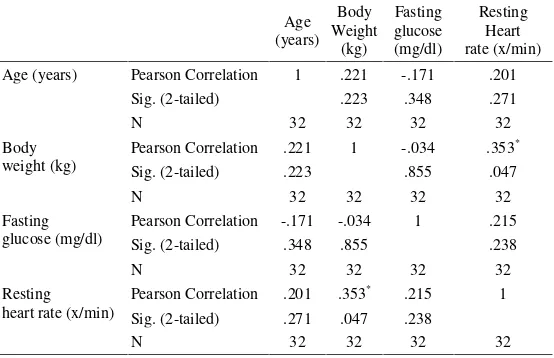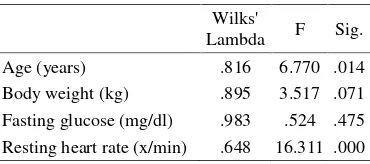Folia Medica Indonesiana Vol. 50 No. 2 April - June 2014 : 110-113
110
AGE AND RESTING HEART RATE ARE DISCRIMINATORS TO PREDICT ENDURANCE
WITHOUT PHYSICAL TEST
Bambang Purwanto, Kristanti Wanito Wigati, Elyana Asnar STP Department of Medical Physiology
Faculty of Medicine, Airlangga University
ABSTRAK
Ketahanan fisik adalah variable terpenting dalam kebugaran berolahraga. Pada umumnya daya tahan ditentukan oleh pengambilan oksigen secara maksimal selama melakukan tes fisik. Kami mencoba untuk mengivestigasi apakah terdapat beberapa factor yang dapat memprediksi ketahanan fisik tanpa melakukan tes fisik. Beberapa data dikumpulkan dari 32 subjek; setengah dari mereka adalah atlet dan lainnya adalah penetap. Usia, berat badan, kadar glukosa darah dan denyut jantung dihitung sebagai faktor prediksi terhadap daya tahan. Subjek diminta melakukan latihan fisik semaksimal mungkin dan durasi dalam waktu dihitung sebagai daya tahan yang diamati. Seluruh data dianalisis untuk distribusi normalitasnya, kolerasi multivariate dan uji discriminator. Kami menemukan bahwa usia dan denyut jantung menentukan daya tahan dengan fungsi z = 0.246.usia + 0.72.denyut jantung–9.057.
Fungsi ini dapat membedakan antara daya tahan fisik yang rendah dan yang tinggi secara signifikan (p=0,0001). Hal ini 81.3% secara tepat menklasifikasikan kategori tingkat daya tahan. Fungsi diskriminator usia dan denyut jantung istirahat, dapat berbeda pada subjek dalam kategori daya tahan tinggi dan rendah secara tepat.(FMI 2014;50:110-113)
Kata kunci:daya tahan fisik, atlet, denyut jantung, tes fisik
ABSTRACT
Physical endurance is the most important variable in sport fitness. Endurance is determined commonly by maximal oxygen uptake (VO2 max) examination during such physical test. We tried to investigate whether there were some factors that could predict physical endurance without any physical test. Some data were collected from 32 subjects; half of them were athletes and other sedentary. Age, body weight, blood fasting glucose and resting heart rate were measured as predicted factors of endurance. The subject asked to hold as long as possible in the maximum exercise intensity and the duration in time was measured as an observed endurance. All data were analyzed for its normality distribution, multivariate correlation and discriminator test. We found that age and resting heart rate determined endurance with the following function was z = 0.246.age + 0.72.resting heart rate–9.057. This
function could differ significantly between low and high category of physical endurance (p = 0.0001). It also 81.3% correctly classified the category of endurance level. Age and resting heart rate were two factors which determine predicted endurance. The discriminator function of age and resting heart rate could distinct correctly the subject into high and low category of endurance. (FMI 2014;50:110-113)
Keywords:physical endurance, athletes, resting heart rate, physical test
Correspondence:Bambang Purwanto, Sport laboratory of Physiology Department, Faculty of Medicine Airlangga University, Jl. Prof. Moestopo 47, Surabaya. Indonesia. Phone: +6231 5023621 & +6281 330535445. Email: [email protected]
INTRODUCTION
Endurance is one of the most important variables in physical fitness (Robergs & Keteyian 2006). It is defined as how long the subject can hold and perform a physical activity under stressing condition (McArdle et al 2010). In order to determine the physical endurance, we commonly measure the maximum oxygen uptake (VO2 max) during such physical test (Akalan et al 2008). Part of this test needs some specific tools, conditions and protocols that practically difficult to perform (Akalan et al 2008, McArdle et al 2010). Coach, physical trainer and talent catcher need a simple guidance to predict endurance more easily and
massively. We tried to investigate some factors which had a strong correlation statistically with physical endurance. These factors were analyzed to distinct endurance into high and low level correctly.
MATERIALS AND METHODS
Subjects were 32 healthy volunteer, consist of 16 athletes and 16 sedentary. They had signed for an informed consent to follow our research protocol. We
performed such physical examination and
Age and Resting Heart Rate are Discriminators to Predict Endurance without Physical Test (Bambang Purwanto et al.)
111
between athletes and sedentary. Subject’s characteristics
such as age, body weight, fasting glucose level and resting heart rate data were collected as predicted factors. These data were analyzed for its normality distribution, multivariate correlation and discriminator test (Kuntoro 2002, Harris & Taylor 2003, Usher-Smith et al 2010). Body weight scale in kilograms was used to measured body weight. Glucose level was measured using easy touch for multi check app with 8 hours fasting before. Heart rate was monitored by polar and cardiac telemetry during rest, exercise and recovery state.
We asked subjects to perform a maximum intensity of cycling as long as possible. The intensity was determined in range of 70 to 90 % of maximum heart rate. Exercise was stopped when they had reached their maximum heart rate target zone (90% heart rate maximum) or the rpm tent to decrease more and more. The duration of maximum cycling was measured for its time in minute as observed endurance (Dalleck & Dalleck 2008, Dimkpa 2009, Gardner et al 2007, Harris & Taylor 2003). Stopwatch was used to measure the duration of endurance. All procedure in material and method had been proven by ethical board of Airlangga University Ethics and Humanity Committee.
RESULTS
The subject’s characteristics showed relative homogene-ous data of age, body weight, fasting glucose level and resting heart rate (p > 0.05). We succeed to match the characteristic between athletes and sedentary.
One Kolmogorov Smirnov sample test was performed to determine the data distribution. The result showed
that our data distribute normally (p > 0.05). We could than perform some parametric test in statistic, such as partial correlation, multivariate correlation and discriminator test.
Table 1. characteristic data of predicted factors
N Min Max Mean SD
age (years) 32 13.00 23.00 17.9375 2.58953
Body weight (kg) 32 47.00 73.00 55.2969 6.75715 Fasting glucose (mg/dl) 32 93.00 134.00 115.9688 11.05553 Resting heart rate (x/min) 32 43.00 100.00 64.3125 14.49458
Table 2. One-Sample Kolmogorov-Smirnov Test Kolmogorov-Smirnov Z 1.115 .806 .701 .773 Asymp. Sig. (2-tailed) .166 .534 .710 .589 Test distribution is Normal.
The correlation between independent variables and dependent variable were tested partially. Age, body weight and resting heart rate showed strong correlation (r≥0.80) with duration of exercise, but fasting glucose showed a weak correlation (r < 0.80). Age correlated positively with duration of exercise, but body weight and resting heart rate correlated negatively with duration of exercise. Age, body weight and resting heart rate were candidate factors to distinct endurance in a discriminator function.
Table 3. Multiple Correlations between predicted factors
Age
Age (years) Pearson Correlation 1 .221 -.171 .201
Sig. (2-tailed) .223 .348 .271
N 32 32 32 32
Body weight (kg)
Pearson Correlation .221 1 -.034 .353*
Sig. (2-tailed) .223 .855 .047
N 32 32 32 32
Fasting glucose (mg/dl)
Pearson Correlation -.171 -.034 1 .215
Sig. (2-tailed) .348 .855 .238
N 32 32 32 32
Resting heart rate (x/min)
Pearson Correlation .201 .353* .215 1 Sig. (2-tailed) .271 .047 .238
Folia Medica Indonesiana Vol. 50 No. 2 April - June 2014 : 110-113
112 All candidate factors were analyzed for multivariate correlation. There was not any strong correlation
between candidate’s predicted factors in characteristic
data (r < 0.8). It means that we could analyze all candidate predicted factors to seek a discriminators function of endurance level.
We found that age and resting heart rate were two predicted factors which could determine endurance level. Body weight and fasting glucose were excluded from the analysis because it failed to distinct endurance level significantly (p > 0.05). The discriminator function were following as z= 0.246 (age) + 0.72 (resting heart rate) – 9.057. This function was succeed to distinct endurance level significantly (p = 0.001). It also correctly classified 81.3% subject in to high or low level endurance. We found that the sensitivity was 84.6% and the specificity was 78.9%.
Table 4. Tests of Equality of Group
Wilks'
Lambda F Sig.
Age (years) .816 6.770 .014
Body weight (kg) .895 3.517 .071
Fasting glucose (mg/dl) .983 .524 .475 Resting heart rate (x/min) .648 16.311 .000
Table 5. Canonical Discriminant Function
Table 6. Test of Function(s) Wilks' Lambda
Wilks' Lambda Chi-square Df Sig.
81.3% of original grouped cases correctly classified.
DISCUSSION
The discriminators function could be an alternative choice to determine endurance level more easily in
practice. It won’t need any specific tools or protocols to
perform physical test. Even though the possibility did not reach 100%, but it is enough for the first step of massive screening before holding any physical test. These findings were restricted to the 21° C in temperature, 98.9% in humidity and 755.5 in barometric pressure. The result could be different in other circumstances.
Age contribute positively in determining physical endurance. Adult subjects performed better than teenage. These finding was similar with Dimpka (2009) study which restricted to subjects between 15-30 years of age. Muscle mass and oxygen uptake (VO2) during exercise much better in adult than teenage. Maximal torque and maximal oxygen uptake (VO2max) reaches it peak level in the early stage of adult (21 years of age), tend to stable for about 10 years than reduce gradually in elderly (Robergs & Keteyian 2006, Gardner et al 2007, McArdle et al 2010).
Resting heart rate contribute negatively in determining physical endurance. It means that subject with lower heart rate could perform exercise longer than subject with a rapid heart rate. Lower heart rate indicates an effective myocardium stroke in order to full fill circular blood need. These subjects were adapted more easily in exercise intensity rising than those who had rapid heart rate in a resting state (Robergs & Keteyian 2006, McArdle et al 2010). These finding was restricted to the healthy subjects, because heart rate bellows 60 times per minute was also a pathological sign of a-rhythmic.
Result of predicted function has two kind of missed classifications, first one was underestimation and the second was overestimation. Underestimation means that the subject performed better than predicted. There must be other factors influenced subject for better endurance during physical test, such as doping administration. It could help to guide the anti doping commissar in collecting urine sample from suspected athlete. Commissars commonly choose the athlete randomly or they choose the winner for doping administration possibilities (ASADA 2008, International Olympic Committee 2010).
Age and Resting Heart Rate are Discriminators to Predict Endurance without Physical Test (Bambang Purwanto et al.)
113 in performing physic for the best result (Robergs & Keteyian 2006, McArdle et al 2010).
CONCLUSION
Age and resting heart rate were two factors which determine predicted endurance. The discriminator function of age and resting heart rate could distinct correctly the subject into high and low category of endurance.
ACKNOWLEDGMENT
This article was part of our research which was funded by Indonesian youth and sport ministry through its deputy assistant of sport science and technology implementation program 2011.
REFERENCES
Akalan C, Robergs RA, Kravitz L (2008). Prediction of VO2 max from an individualized submaximal cycle ergometer protocol. Journal of Exercise Physiologyonline 11, 1-17
ASADA (2008). ASADA Anti-Doping Handbook, 11th ed., Australia, Australian Sports Anti-Doping Authority
Dalleck L and Dalleck A (2008). The ACSM exercise in tensity guidelines for cardiorespiratory fitness: why the misuse? Journal of Exercise Physiologyonline 11, 1-11
Dimkpa U (2009). Post-exercise heart rate recovery: an index of cardiovascular fitness. Journal of Exercise Physiologyonline 12, 10-22
Gardner AS, Martin JC, Martin DT, Barras M, Jenkins DG (2007). Maximal torque- and power-pedaling rate relationships for elite sprint cyclists in laboratory and field tests. Eur J Appl Physiol 101, 287-292
Harris M and Taylor G (2003). Medical Statistics Made Easy, London and New York, Martin Dunitz Taylor & Francis Group
International Olympic Committee (2010). Anti-Doping Rules Applicable to the XXI Olympic Winter Games in Vancouver, Vancouver, The International Olympic Committee
Kuntoro H (2002). Pengantar Statistika Multivariat, Surabaya, Pustaka Melati
McArdle WD, Katch FI, Katch VL (2010). Essentials of Exercise Physiology, 4th ed., Philadelphia, Lippincott Williams & Wilkins
Robergs RA and Keteyian SJ (2006). Fundamentals of Exercise Physiology for Fitness, Performance and Health, New York, McGraw Hills Comp

